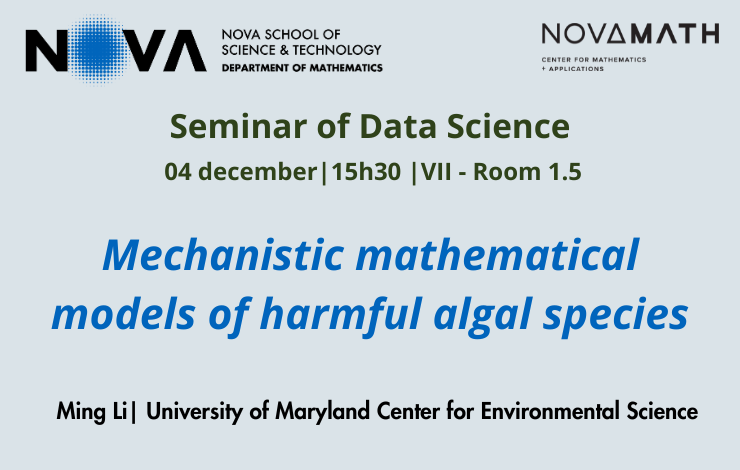MENU
12-11-2024

The Center of Mathematics and Applications (NOVA Math), promote the Seminar of Data Science with the title: “Mechanistic mathematical models of harmful algal species” Ming Li (University of Maryland Center for Environmental Science) is the speaker.
Abstract: Harmful algal blooms (HABs) are escalating worldwide, recognized to be significantly associated with human-induced nutrient pollution. There is little doubt that there are now more HABs, more often, in new and different places, often lasting longer, affecting ecosystem and human health with a range of toxicities. In particular, filter-feeding organisms such as shellfish may accumulate high levels of HABs-produced toxins, and act as marine toxin vectors to humans. There is also little doubt that climate change is impacting the pattern, distribution and intensity of HABs in complex ways, from warming of waters, to altered stratification and changing precipitation patterns. Mathematical models are being developed to predict HABs. Many are based on statistical or empirical models constructed from observational data, but they are only interpretable within the limits of the observational data used to generate them. Another modeling approach is a mechanistic model based on mathematical equations that describe HAB growth in terms of mathematical formulation of biogeochemical and physiological processes such as nutrient uptake, photosynthesis and grazing. Coupling mechanistic HAB models to three-dimensional ocean circulation models is still a relatively nascent field. For HABs where physical transport provides the dominant control on bloom distribution, a Lagrangian approach, tracking passive particles or individuals with behavior, has proven to be effective. For HABs in which eutrophication is a major driver for their proliferation, a mechanistic model needs to explicitly consider nutrient input, nutrient kinetics, plankton physiology and mixotrophic feeding. In this talk I will describe our recent efforts in developing mechanistic models for three HAB species: Prorocentrum minimum and Karlodinium veneficum in the Chesapeake Bay and Karenia brevis on the West Florida Shelf.
Wednesday, 04 december, 15h30.